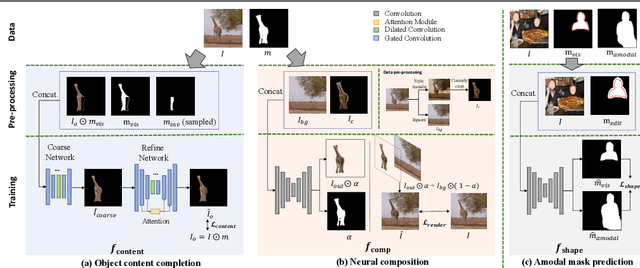Denis Demandolx
UnSAMFlow: Unsupervised Optical Flow Guided by Segment Anything Model
May 04, 2024



Abstract:Traditional unsupervised optical flow methods are vulnerable to occlusions and motion boundaries due to lack of object-level information. Therefore, we propose UnSAMFlow, an unsupervised flow network that also leverages object information from the latest foundation model Segment Anything Model (SAM). We first include a self-supervised semantic augmentation module tailored to SAM masks. We also analyze the poor gradient landscapes of traditional smoothness losses and propose a new smoothness definition based on homography instead. A simple yet effective mask feature module has also been added to further aggregate features on the object level. With all these adaptations, our method produces clear optical flow estimation with sharp boundaries around objects, which outperforms state-of-the-art methods on both KITTI and Sintel datasets. Our method also generalizes well across domains and runs very efficiently.
AnyFlow: Arbitrary Scale Optical Flow with Implicit Neural Representation
Mar 29, 2023



Abstract:To apply optical flow in practice, it is often necessary to resize the input to smaller dimensions in order to reduce computational costs. However, downsizing inputs makes the estimation more challenging because objects and motion ranges become smaller. Even though recent approaches have demonstrated high-quality flow estimation, they tend to fail to accurately model small objects and precise boundaries when the input resolution is lowered, restricting their applicability to high-resolution inputs. In this paper, we introduce AnyFlow, a robust network that estimates accurate flow from images of various resolutions. By representing optical flow as a continuous coordinate-based representation, AnyFlow generates outputs at arbitrary scales from low-resolution inputs, demonstrating superior performance over prior works in capturing tiny objects with detail preservation on a wide range of scenes. We establish a new state-of-the-art performance of cross-dataset generalization on the KITTI dataset, while achieving comparable accuracy on the online benchmarks to other SOTA methods.
Efficient and Explicit Modelling of Image Hierarchies for Image Restoration
Mar 01, 2023Abstract:The aim of this paper is to propose a mechanism to efficiently and explicitly model image hierarchies in the global, regional, and local range for image restoration. To achieve that, we start by analyzing two important properties of natural images including cross-scale similarity and anisotropic image features. Inspired by that, we propose the anchored stripe self-attention which achieves a good balance between the space and time complexity of self-attention and the modelling capacity beyond the regional range. Then we propose a new network architecture dubbed GRL to explicitly model image hierarchies in the Global, Regional, and Local range via anchored stripe self-attention, window self-attention, and channel attention enhanced convolution. Finally, the proposed network is applied to 7 image restoration types, covering both real and synthetic settings. The proposed method sets the new state-of-the-art for several of those. Code will be available at https://github.com/ofsoundof/GRL-Image-Restoration.git.
AMICO: Amodal Instance Composition
Oct 11, 2022



Abstract:Image composition aims to blend multiple objects to form a harmonized image. Existing approaches often assume precisely segmented and intact objects. Such assumptions, however, are hard to satisfy in unconstrained scenarios. We present Amodal Instance Composition for compositing imperfect -- potentially incomplete and/or coarsely segmented -- objects onto a target image. We first develop object shape prediction and content completion modules to synthesize the amodal contents. We then propose a neural composition model to blend the objects seamlessly. Our primary technical novelty lies in using separate foreground/background representations and blending mask prediction to alleviate segmentation errors. Our results show state-of-the-art performance on public COCOA and KINS benchmarks and attain favorable visual results across diverse scenes. We demonstrate various image composition applications such as object insertion and de-occlusion.
 Add to Chrome
Add to Chrome Add to Firefox
Add to Firefox Add to Edge
Add to Edge